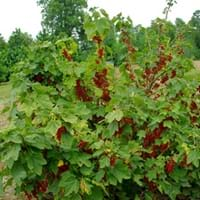Life Span
Perennial
Perennial
Origin
Europe, Central Asia, Western Asia
Europe, Asia
Types
Rovada, ‘Red Lake’ AGM, Junifer
Not Available
Habitat
Broad-Leaved Forests, shores, Stream side
Dry areas, Roadsides, stream banks, Stream side, Waste areas
USDA Hardiness Zone
3-8
3-7
Sunset Zone
Not Available
1a, 1b, 2a, 2b, 3a, 3b, 4, 5, 6, 7, 8, 9, 10, 11, 12, 13, 14, 15, 16, 17, 18, 19, 20, 21, 22, 23, 24
Habit
Upright/Erect
Clump-Forming
Flower Color
Green
White, Lavender
Flower Color Modifier
Bicolor
Bicolor
Fruit Color
White, Red, Pink, Ivory
Sandy Brown
Leaf Color in Spring
Green
Gray Green, Gray
Leaf Color in Summer
Green
Gray Green, Gray
Leaf Color in Fall
Yellow, Green
Gray Green, Gray
Leaf Color in Winter
Light Green
Light Green
Leaf Shape
Maple shaped
Arrowhead
Plant Season
Summer
Spring, Summer, Fall
Sunlight
Full Sun, Partial Sun, Partial shade
Full Sun, Partial Sun
Type of Soil
Loam
Clay, Loam, Sand
The pH of Soil
Acidic, Neutral
Acidic, Neutral, Alkaline
Soil Drainage
Well drained
Well drained
Bloom Time
Early Spring, Spring
Summer, Late Summer, Early Fall
Tolerances
Drought
Drought, Dry soil
Where to Plant?
Container, Ground, Pot
Container, Ground
How to Plant?
Divison, Seedlings
Seedlings
Plant Maintenance
Medium
Low
Watering Requirements
occasional watering once established, Requires watering in the growing season
Do Not over Water, Never Over-water, Requires regular watering, Water when soil is dry
In Summer
Lots of watering
Lots of watering
In Spring
Moderate
Moderate
In Winter
Average Water
Average Water
Soil pH
Acidic, Neutral
Acidic, Neutral, Alkaline
Soil Type
Loam
Clay, Loam, Sand
Soil Drainage Capacity
Well drained
Well drained
Sun Exposure
Full Sun, Partial Sun, Partial shade
Full Sun, Partial Sun
Pruning
Prune every year, Prune to half of its height, Prune to stimulate growth
Prune if you want to improve plant shape, Prune in spring, Remove damaged leaves, Remove dead leaves
Fertilizers
Citrus, Fertilize every year
fertilize every 2-3 weeks while growing, fertilize in growing season
Pests and Diseases
Aphids, Birds, Borers, Red blotch
Caterpillars, Leaf Hoppers, Nematodes, Spider mites
Plant Tolerance
Drought
Drought, Frost
Flower Petal Number
Single
Single
Fragrant Bark/Stem
No
Yes
Foliage Texture
Medium
Medium
Foliage Sheen
Not Available
Matte
Attracts
Birds
Flying insects, Insects, Spider Mites
Allergy
Asthma
Avoid during Pregnancy, Headache, Stomach pain, Vomiting
Aesthetic Uses
Showy Purposes
Beautification, Landscape Designing, Showy Purposes
Beauty Benefits
Not Available
Not Available
Environmental Uses
Not Available
Air purification
Medicinal Uses
Iron, Phosphorus, Vitamin B, Vitamin C
Arthritis, Cold, constipation, Fever, Insomia, Migraines, Upset stomach
Part of Plant Used
Fruits, Whole plant
Whole plant
Other Uses
Culinary use, Used As Food, Used as Ornamental plant
Air freshner, Decoration Purposes, Employed in herbal medicine, Making Perfumes, Making Shampoo, Making Sweet Scented Oil, Medicinal oil, Used as Ornamental plant, Used for its medicinal properties
Used As Indoor Plant
Yes
Yes
Used As Outdoor Plant
Yes
Yes
Garden Design
Edible, Fruit / Fruit Tree, Hedges, Mixed Border
Container, Herb / Vegetable, Mixed Border
Botanical Name
RIBES rubrum
NEPETA cataria
Common Name
Red Currant
Cat Nip, Catnip
In Hindi
Red Currant
कटनीप
In German
Rote Johannisbeere
Katzenminze
In French
Groseille
cataire
In Spanish
Grosella
Catnip
In Greek
Κόκκινη σταφίδα
Είδος δυόσμου
In Portuguese
Groselha
catnip
In Polish
Porzeczkowy
Kocimiętka
In Latin
red RIBES
catnip
Phylum
Magnoliophyta
Magnoliophyta
Class
Magnoliopsida
Magnoliopsida
Family
Grossulariaceae
Lamiaceae
Clade
Angiosperms, Core eudicots, Eudicots
Angiosperms, Asterids, Eudicots
Tribe
Not Available
Mentheae
Subfamily
Not Available
Nepetoideae
Number of Species
Not Available
Importance of Red Currant and Catnip
Want to have the most appropriate plant for your garden? You might want to know the importance of Red Currant and Catnip. Basically, these two plants vary in many aspects. Compare Red Currant and Catnip as they differ in many characteristics such as their life, care, benefits, facts, etc. Every gardener must at least have the slightest clue about the plants he wants to plant in his garden. Compare their benefits, which differ in many ways like facts and uses. The medicinal use of Red Currant is Iron, Phosphorus, Vitamin B and Vitamin C whereas of Catnip is Arthritis, Cold, constipation, Fever, Insomia, Migraines and Upset stomach. Red Currant has beauty benefits as follows: Not Available while Catnip has beauty benefits as follows: Not Available.
Compare Facts of Red Currant vs Catnip
How to choose the best garden plant for your garden depending upon its facts? Here garden plant comparison will help you to solve this query. Compare the facts of Red Currant vs Catnip and know which one to choose. As garden plants have benefits and other uses, allergy is also a major drawback of plants for some people. Allergic reactions of Red Currant are Asthma whereas of Catnip have Avoid during Pregnancy, Headache, Stomach pain and Vomiting respectively. Having a fruit bearing plant in your garden can be a plus point of your garden. Red Currant has showy fruits and Catnip has no showy fruits. Also Red Currant is not flowering and Catnip is not flowering . You can compare Red Currant and Catnip facts and facts of other plants too.





